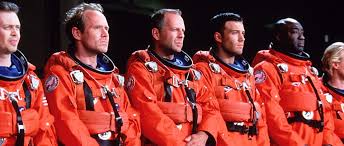Weltraummissionen: Welche weckt eure Freude, Interesse?
24.04.2017 um 18:41Hi, die NASA plant ja wieder so einiges, genauso wie SpaceX
Unabhängig davon wie lange man noch für die Umsetzung brauch, auf welche Mission freut ihr euch oder welche findet ihr Interessant? (Reihenfolge bei Abstimmung nach Gefühl)
Asteroid Redirect Mission
NASA is developing a first-ever robotic mission to visit a large near-Earth asteroid, collect a multi-ton boulder from its surface, and use it in an enhanced gravity tractor asteroid deflection demonstration. The spacecraft will then redirect the multi-ton boulder into a stable orbit around the moon, where astronauts will explore it and return with samples in the mid-2020s.
Osiris-REx
OSIRIS-REx will travel to a near-Earth asteroid called Bennu and bring a small sample back to Earth for study. As planned, the spacecraft will reach Bennu in 2018 and return a sample to Earth in 2023.
Europa Clipper Mission
Europa has long been a high priority for exploration because it holds a salty liquid water ocean beneath its icy crust. The ultimate aim of Europa Clipper is to determine if Europa is habitable, possessing all three of the ingredients necessary for life: liquid water, chemical ingredients, and energy sources sufficient to enable biology. The mission is being planned for launch in the 2020s, arriving in the Jupiter system after a journey of several years.
Mars InSight
InSight (Interior Exploration using Seismic Investigations, Geodesy and Heat Transport) is a NASA Discovery Program mission that will place a single geophysical lander on Mars to study its deep interior. But InSight is more than a Mars mission - it is a terrestrial planet explorer that will address one of the most fundamental issues of planetary and solar system science - understanding the processes that shaped the rocky planets of the inner solar system (including Earth) more than four billion years ago By using sophisticated geophysical instruments, InSight will delve deep beneath the surface of Mars, detecting the fingerprints of the processes of terrestrial planet formation, as well as measuring the planet's "vital signs": Its "pulse" (seismology), "temperature" (heat flow probe), and "reflexes" (precision tracking).
Exploration Mission-1
The first of these missions will launch NASA's powerful new rocket, the Space Launch System, from NASA’s Kennedy Space Center in Florida. The mission will carry the Orion spacecraft (without astronauts) thousands of miles beyond the moon during an approximately three week mission. Next up, astronauts will climb into Orion for a similar mission, traveling farther than humans have ever traveled before. Also in the 2020s, we'll send astronauts on a yearlong mission into this deep space proving ground, verifying habitation and testing our readiness for Mars.
Oder
wenn irgendjemand in den 2020er zurück zum Mond findet?
Den Weltraumtourismus?
Die Reise zum Mars?
Unabhängig davon wie lange man noch für die Umsetzung brauch, auf welche Mission freut ihr euch oder welche findet ihr Interessant? (Reihenfolge bei Abstimmung nach Gefühl)
Asteroid Redirect Mission
NASA is developing a first-ever robotic mission to visit a large near-Earth asteroid, collect a multi-ton boulder from its surface, and use it in an enhanced gravity tractor asteroid deflection demonstration. The spacecraft will then redirect the multi-ton boulder into a stable orbit around the moon, where astronauts will explore it and return with samples in the mid-2020s.
Osiris-REx
OSIRIS-REx will travel to a near-Earth asteroid called Bennu and bring a small sample back to Earth for study. As planned, the spacecraft will reach Bennu in 2018 and return a sample to Earth in 2023.
Europa Clipper Mission
Europa has long been a high priority for exploration because it holds a salty liquid water ocean beneath its icy crust. The ultimate aim of Europa Clipper is to determine if Europa is habitable, possessing all three of the ingredients necessary for life: liquid water, chemical ingredients, and energy sources sufficient to enable biology. The mission is being planned for launch in the 2020s, arriving in the Jupiter system after a journey of several years.
Mars InSight
InSight (Interior Exploration using Seismic Investigations, Geodesy and Heat Transport) is a NASA Discovery Program mission that will place a single geophysical lander on Mars to study its deep interior. But InSight is more than a Mars mission - it is a terrestrial planet explorer that will address one of the most fundamental issues of planetary and solar system science - understanding the processes that shaped the rocky planets of the inner solar system (including Earth) more than four billion years ago By using sophisticated geophysical instruments, InSight will delve deep beneath the surface of Mars, detecting the fingerprints of the processes of terrestrial planet formation, as well as measuring the planet's "vital signs": Its "pulse" (seismology), "temperature" (heat flow probe), and "reflexes" (precision tracking).
Exploration Mission-1
The first of these missions will launch NASA's powerful new rocket, the Space Launch System, from NASA’s Kennedy Space Center in Florida. The mission will carry the Orion spacecraft (without astronauts) thousands of miles beyond the moon during an approximately three week mission. Next up, astronauts will climb into Orion for a similar mission, traveling farther than humans have ever traveled before. Also in the 2020s, we'll send astronauts on a yearlong mission into this deep space proving ground, verifying habitation and testing our readiness for Mars.
Oder
wenn irgendjemand in den 2020er zurück zum Mond findet?
Den Weltraumtourismus?
Die Reise zum Mars?



